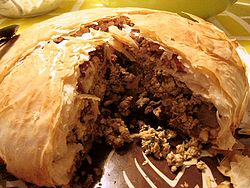Pastilla
 | |
| Jeneng liyané | Pastel |
|---|---|
| Jinis | Meat pie |
| Panggonan asal | Al-Andalus |
| Tlatah utawa praja | Morocco, Algeria, France, Israel, North America, Tunisia |
| Woworan pokok | Warka dough, broth, spices; squab, chicken, fish or offal |
Pastilla ( Moroccan Arabic بسطيلة ) minangka panganan tradisional Afrika Lor sing bentuké pie manis utawa pai daging sing pedhes karo werqa ( ورقة ), godhong adonan sing padha karo phyllo . Disebutake asalé saka Andalusi lan ditulis kanthi sejarah supaya bisa digunakake ing Maroko lan Algeria, mula diarani r'zima ( رزيمة ) utawa tajik .[1][2] Iki luwih bubar nyebar dening emigran menyang Prancis, Israel, lan Amerika Lor .
Asal
[besut | besut sumber]Jeneng pie asale saka tembung pastilla Spanyol, tegese ing Spanyol modern salah siji "pil" utawa "pastry cilik" sawise owah-owahan fonèm "p" dadi "b" sing khusus kanggo basa Arab .[3] Peneliti Anny Gaul mbuktekake resep-resep sing nuduhake "meh padha karo barang-barang sing lumebu ing bastila modern" ing abad ka-13 Andalusi buku-buku, kaya ta Ibn Razīn al-Tujībī " Faḍālat al-khiwān fī ṭayyibāt al-ṭaʻām wa-al -alwān "( فضالة الخوان في طيبات الطعام والألوان ).[1][4]
Versi Yahudi Sephardic
[besut | besut sumber]Antarane Yahudi Maroko, pastila digawé nganggo lenga zaitun utawa margarin kanggo ngetutake aturan sing luwih kosher .
Varian sing saya tambah akeh ndadekake pastri individu tinimbang pai.[5]
Kapustakan
[besut | besut sumber]- ↑ a b Gaul, Anny (2019-11-27). "Bastila and the Archives of Unwritten Things". Maydan (ing basa Inggris Amérika Sarékat). Dibukak ing 2019-12-13.
I was especially interested in Tetouani baqlawa, a pastry typically associated with the eastern Mediterranean, not the west. The baqlawa we sampled was shaped in a spiral, unlike the diamond-shaped version I was more familiar with from Levantine food. But its texture and flavors––thin buttered layers of crisp papery pastry that crunch around sweet fillings with honeyed nuts––were unmistakable. Instead of the pistachios common in eastern baqlawa, El Mofaddal’s version was topped with toasted slivered almonds. Was baqlawa the vehicle that had introduced phyllo dough to Morocco?
There is a strong argument for the Turkic origin of phyllo pastry, and the technique of shaping buttered layers of it around sweet and nut-based fillings was likely developed in the imperial kitchens of Istanbul.[4] So my next step was to find a likely trajectory that phyllo dough might have taken from Ottoman lands to the kitchens of northern Morocco.
It so happened that one of Dr. Bejjit’s colleagues, historian Idriss Bouhlila, had recently published a book about the migration of Algerians to Tetouan in the nineteenth/thirteenth century. His work explains how waves of Algerians migrated to Tetouan fleeing the violence of the 1830 French invasion. It includes a chapter that traces the influences of Ottoman Algerians on the city’s cultural and social life. Turkish language and culture infused northern Morocco with new words, sartorial items, and consumption habits––including the custom of drinking coffee and a number of foods, especially sweets like baqlawa. While Bouhlila acknowledges that most Tetouanis consider bastila to be Andalusi, he suggests that the word itself is of Turkish origin and arrived with the Algerians."
...
"Bouhlila’s study corroborated the theory that the paper-thin ouarka used to make bastila, as well as the name of the dish itself, were introduced to Morocco by way of Tetouani cuisine sometime after 1830. - ↑ "Migrations" (PDF). www.hommes-et-migrations.fr. Diarsip saka sing asli (PDF) ing 2015-09-24. Dibukak ing 2020-08-04.
- ↑ Bastilla. Clifford A Wright. 2016
- ↑ Ibn Razīn al-Tuǧībī, ʻAlī b. Muḥammad; Ibn Šaqrūn, Muḥammad (1984). Fuḍālat al-k̲iwān fī ṭayyibāt al-ṭaʻām wa-al-alwān: ṣūra min fann al-ṭabk̲ fī al-Andalus wa-al-Maġrib fī bidāyat ʻaṣr Banī Marīn li-Ibn Razīn al-Tuǧībī . Bayrūt: Dār al-Ġarb al-Islāmī. OCLC 776451991.
- ↑ Solomonov, Michael (2016). Zahav: A World of Israeli Cuisine. HMH.
